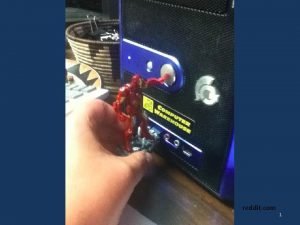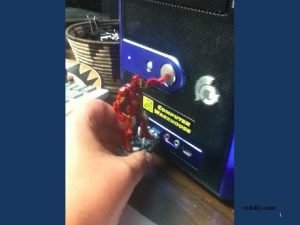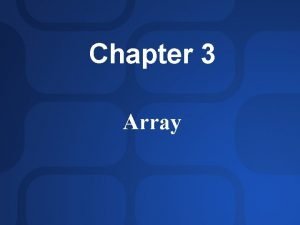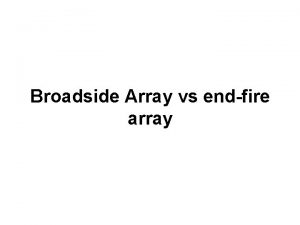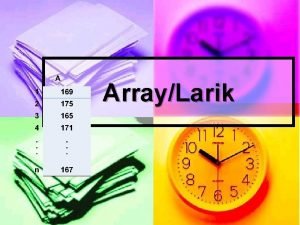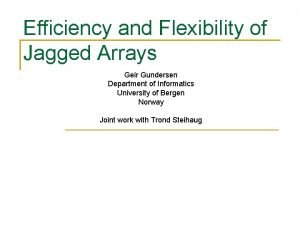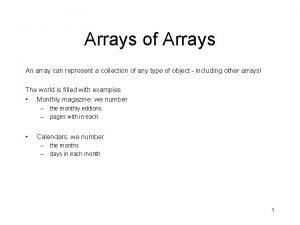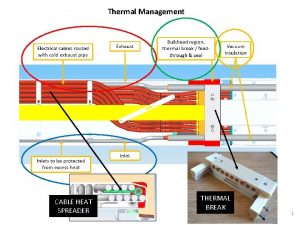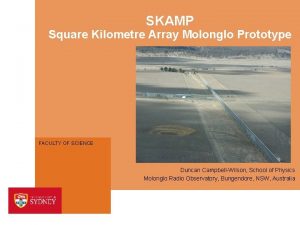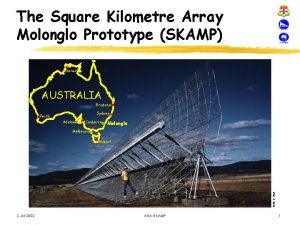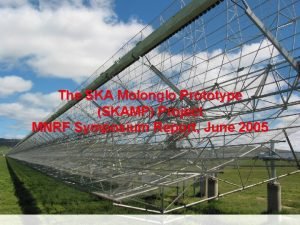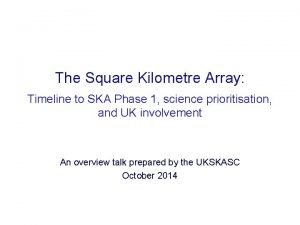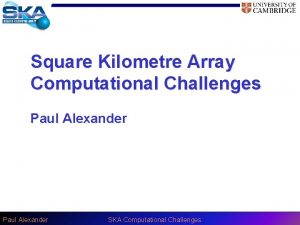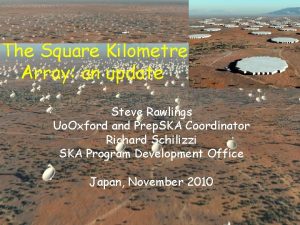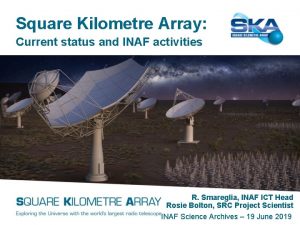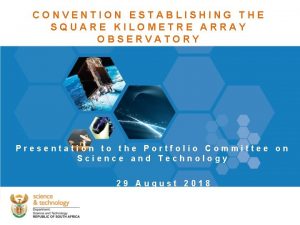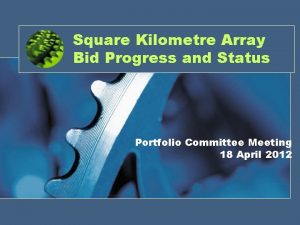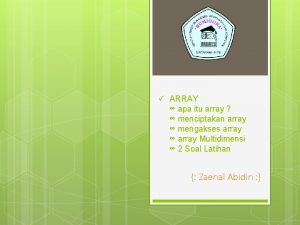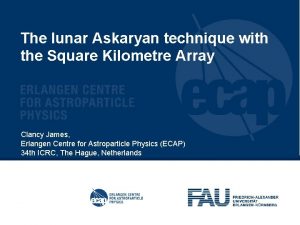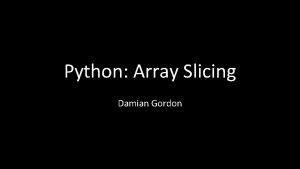SKAMP Square Kilometre Array Molonglo Prototype FACULTY OF



























- Slides: 27

SKAMP Square Kilometre Array Molonglo Prototype FACULTY OF SCIENCE Duncan Campbell-Wilson, School of Physics Molonglo Radio Observatory, Bungendore, NSW, Australia

Cylindrical Antenna 18, 0000 m 2

SKAMP Development Strategy SKAMP 1: Gain experience with FPGA technology, but use existing MOST analogue infrastructure. SPARTAN 2 -3 Xilinix FPGAs used for signal processing and complex correlation. SKAMP 2: Take the lessons learnt from SKAMP 1 to develop a multi-channel correlator system with spectral line and continuum capability. Based on Virtex 4 technology. SKAMP 3: New feed design with full polarisation and integrated low cost LNAs. Some exploratory work already complete.

SKAMP 3 Development Goals Design a new cost-effective broadband feed system to replace the current mechanically driven beam-steering system. Frequency agile and compatible with the detector system built for SKAMP 2. Change the front end receivers to accept bandwidth of 94 MHz within the range 700 -1400 MHz

SKAMP 2 Design Goals Compatibility with MOST and SKAMP 1. Major change to digital signal transport on optical fibres and digital signal processing using FPGAs. 368 individual antenna systems: 352 for astronomy and 16 for RFI mitigation and testing

Variable Cosmic Radio Sources

SKAMP 2 -3 Signal Pathway Antenna to Low Noise Amplifier (LNA) LNA to receiver Receiver fixed 30 MHz BW at 843 MHz; down-converted to baseband (SKAMP 2) Receiver frequency agile with 100 MHz BW; down-converted to baseband in IQ format (SKAMP 3) Digitised to 8 bits Serialised in the Lattice FPGA Sent on 850 nm optical fibre to the control room for digital signal processing

Polyphase Signal Pathway Optical to electrical conversion Delay First level (coarse) FFT performed in the first stage (PFB A) Second level (fine) FFT produces ~14 k. Hz frequency channels (PFB B) Signals aligned to stop the fringes and adjust signal amplitude Data re-ordered and serialised for transfer to the correlator Some sections working but full integration is incomplete

PFB Output Spectrum (RFI antenna)

Correlator 24 boards, each handling approx 4 MHz of bandwidth 48 independent outputs, feeding into ethernet switches Two computers handle the data reduction, under control of a third computer Readout every 32 seconds for normal observations

SKAMP II correlator board

Loaded PFB and Correlator Racks

Status: Polyphase Filter and Correlator All prototype boards completed and tested 27/27 production correlator boards complete delivery April 2011 27 Correlator Rear Transition Modules (CRTM) and Optical Rear Transition Modules (ORTM) delivered. Front panel fit-off complete 27 production PFB boards complete January 2011.

Correlator Status Close to full operation Long term accumulator is outstanding but underway System verification is incomplete Input and output interfaces passing correct test data About 2 months left to complete the firmware

Receiver specifications Design capable of accepting 700 -1400 MHz, with output bandwidth 100 MHz Analogue input, with digital output in IQ format; fibre optic transmission Environmental monitoring; local gain and offset control

Down-converter Attributes Wideband input 700 -2800 MHz Gain compensation vs temperature I/Q outputs Four receivers per down-converter board One local oscillator (low phase-noise margin)

RX Digitiser Board

RX Diagnostics Diagnostic features included as part of the design Diagnostics along the signal path to allow remote fault-finding Diagnostic functions kept independent of each other

RX System Diagnostics Two Tone test Checker Board test Half Scale Pseudo random binary sequence Power supply voltage monitoring Down-converter temperature monitoring Digitiser temperature monitoring

RX Remote Control Programmable down-converter; pseudo-logarithmic gain control Linearly programmable ADC offset control Linearly programmable ADC voltage reference System under test for reliability and debugging

RX Development Status Slow firmware development; correlator firmware has priority Down-converter boards production-ready; assembly underway Digital RX FPGA boards not yet production-ready FPGA placement reliability; need for rework

RX Diagnostic Spectrum

PFB and Correlator Firmware • PFB firmware – still to do: time delay, fringe stopping, amplitude adjustment • Limited testing • Correlator firmware in good shape; long term accumulator incomplete

Software Status Data processing pipeline has been tested Diagnostic software under development SKAMP 2 system control still to be extended from single board to full system Telescope control computer interface complete Calibration: no significant work

Astronomical Calibration Selection parameters for calibrators: flux density, spectral index, angular size, variability and declination Molonglo Southern 4 Jy survey (MS 4; Burgess & Hunstead 2006, Table 5) is an excellent starting point for SKAMP 2 calibration.

Displaying Visibilities

System Calibration Temperature dependent gain calibration Delay calibration Frequency dependent gain and phase Fine channel calibration
 Km-hm-dam-m-dm-cm-mm
Km-hm-dam-m-dm-cm-mm Rapid prototyping video
Rapid prototyping video Prototype 1 vs 2 reddit
Prototype 1 vs 2 reddit Associative array vs indexed array
Associative array vs indexed array Contoh array 2 dimensi python
Contoh array 2 dimensi python Pin grid array and land grid array
Pin grid array and land grid array Endfire array
Endfire array Photovoltaic array maximum power point tracking array
Photovoltaic array maximum power point tracking array Array tiga dimensi
Array tiga dimensi Larik adalah
Larik adalah Jagged array
Jagged array Sparse array adalah array yang
Sparse array adalah array yang Magic square wrap around array java
Magic square wrap around array java Biostatistics examples
Biostatistics examples 12 square numbers
12 square numbers Foil method biology
Foil method biology Find each square root
Find each square root Cube nimbers
Cube nimbers 1 to 30 cube
1 to 30 cube Square root multiplied by square root
Square root multiplied by square root Vgr (prototype demo)
Vgr (prototype demo) Patched up prototype
Patched up prototype Patched up prototype
Patched up prototype Prototype assembly modem
Prototype assembly modem Prototype all landmarks
Prototype all landmarks Explore evolve validate prototype
Explore evolve validate prototype Gambar model prototyping
Gambar model prototyping Egg drop challenge ideas
Egg drop challenge ideas

